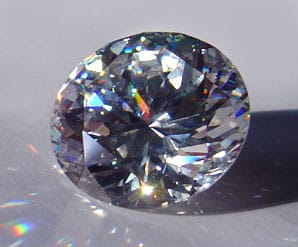Cubic Zirconia (CZ)
Cubic Zirconia is currently the most popular substitute to a diamond because to the untrained eye they look identical. Cubic Zirconia, or CZ as it is referred to, is made from zirconium dioxide, a different material than diamonds, which although a different chemical composition comes closer than any other gem to matching the characteristics of a diamond.

Natural CZ was first discovered in 1899 but it wasn’t until the late 70’s that man made CZ first came into production for use in jewellery. CZ on first impression looks just like a diamond but under close inspection there are differences, it has a gravity of between 5.6 and 6.0 which means it’s 1.6 times the weight of a diamond. It has a hardness of 8 on the Mohs scale, a refraction index of 2.176 and a dispersive power of 0.060, which means that it’s not as hard as a diamond, it’s slightly less sparkly but displays more prismatic fire which means more colour sparkles within the gem.
Another point to note is that natural diamonds display impurities which CZ doesn’t, its also clear in colour which most diamonds aren’t, but they can be coloured by adding metal oxides in the production process.
Unlike diamonds, CZ are good thermal insulators which mean they become warm but can’t withstand the same kind of heat a diamond can, which is one test that is used to distinguish diamonds from CZ.
Caring for CZ is important because they are more brittle than diamonds and susceptible to wear and tear such as chipping and scratches over time.
